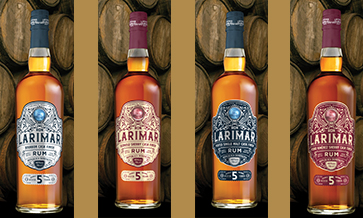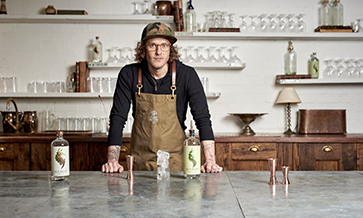Sand-filtered water, ginger juice extracted the same day as it is used, organic holy basil from Uttar Pradesh and London-based mixologists working on the blend. The list could go on… We’re talking about a category that has been bubbling over the last few years that we call by many names: adult soft beverages, sophisticated softs, or NoLo (no- and low-alcohol) beverages, but which all boil down to the same thing.
The global movement towards NoLo (no- and low-alcohol) beverages started as early as in 2004, with companies like Fever Tree and many others. In India the emergence of home-grown premium tonic waters in 2018 initiated the movement, and the right kind of buzz made it popular.
This is also analogous to what we have seen in the beer segment in India. Craft beer in bottles or cans, or on tap from your favourite micro-brewery, is still only a fraction of the beer market in India, but has captured a disproportionate share of the conversation.
Similarly, in this space, traditional aerated soft drinks and juices still dominate the landscape. But these craft NoLo beverages have not just proliferated, but also created sub-categories where none existed until some years ago. We can divide them into:
- Traditional mixers: tonic, ginger ale, ginger beer, lemonade, soda, etc.
- Ready-to-drink (RTD) and zero-proof drinks, including soft non-alcoholic seltzers
- Low-alcohol beer (0.0% ABV)
- Non-alcoholic distilled spirits.
Gone are the days when tea or coffee was the hot beverage of choice, and colas or juices were common cold drinks. In just the past 3 years, the Indian NoLo beverage industry has come a long way and seems to be stronger than ever.
Several drivers
The majority of consumption is led by people between the age group of 18 and 40. According to Goldstein Market Intelligence analysis, “Indian packaged non-alcoholic beverages market is expected to grow at a CAGR of 16.2% during 2017-2030”.
There have been several drivers for this evolution and shift in consumer preference. The chief villains (or shall we say heroes?) of the piece, as always, are travel and social media. International travel definitely exposed Indian consumers to more evolved choices than they were hitherto used to.
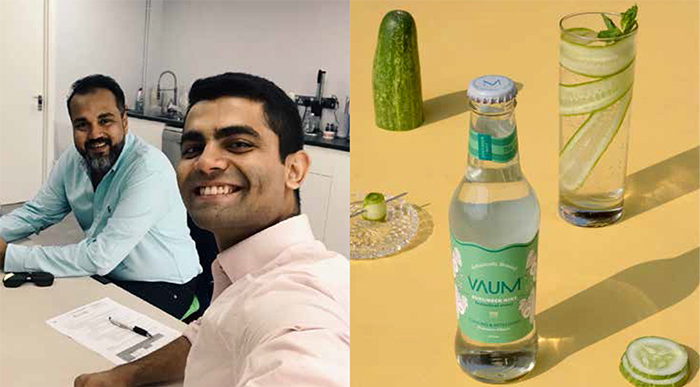
Goa-based founders of Vaum, Aakash Khaunte and Siddharth Saraf (L) have introduced quinine-free botanical waters such as the cucumber-mint combination (R).
With the onset of the Covid-19 pandemic and long periods of lockdowns and physical distancing, it was social media that has given them a window to a foreign world.
Next is the increased consciousness of what we put in our bodies, with a growing shift (at least in Tier-1 cities) away from sugary drinks to beverages that have no or low sugar content and have natural ingredients.
Rishabh Gupta of Bengal Bay tonic says, “The new age consumer is willing to spend a premium on products that are natural, low in sugar or sugar-free, and provide functional benefits.” This consumer is also increasingly keen on delving behind the label and understanding what goes into the product.
Gin is the new poster boy of the spirits world in India, helped by an explosion in home-grown craft gins, and further accentuated by new releases from major international brands.
Greater Than and Stranger&Sons are believed to be touching a combined 1 lakh cases a year in sales, which translates into a lot of tonic to go along with it!
“Things are still looking up in 2021; the only change is that we now know that India holds some serious potential as a market in the global gin scene,” says Anand Virmani of Greater Than. The increase in variety of tonic flavours to pair with gin elevates the consumer drinking experiences and opens a whole new world of exceptional drinks to enjoy.

Aneesh Bhasin’s (L) Svami Drinks home-grown tonics have led to a slew of Indian brands jumping on to the bandwagon.
Home alone!
Coupled with this is the focus on a Highball strategy by whiskey brands such as Jameson and Jim Beam, with ginger ale a de facto mixer of choice for both.
Linked to the pandemic and social disruptions is the evolution of a segment that Sophia Sinha, marketing head of Moet Hennessy refers to as the “home premise”, a new theatre in the battle for a share of the customer’s gullet.
With consumers stuck at home for increasing lengths of time, they are keen to get an experience as close as they can have at their favourite bar, and also with the minimum of effort or expertise.
Coupled with the trend to drinking better is the fact that this most of the time also represents a trend to premiumisation, so not just in the spirit of your choice but also in the mixer. Let us take a deep dive into each of the segments that we mentioned above.
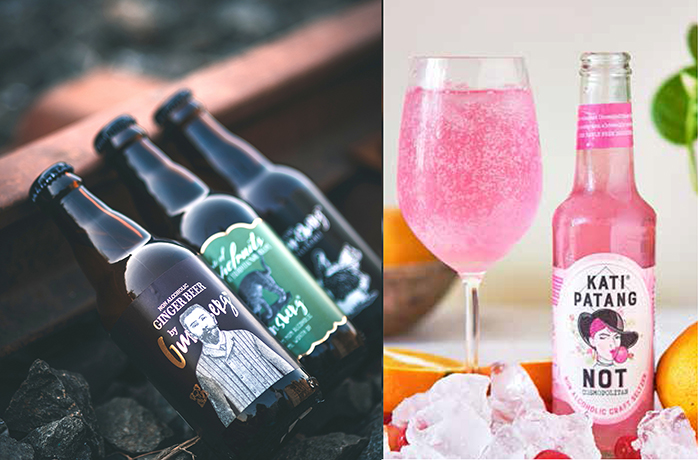
Punjab-based Gunsberg (L) sources and juices its ginger from Sirmour, Himachal Pradesh. Kati Patang (R) ‘non-alcoholic craft cocktails’ include the Cosmopolitan.
Traditional mixers
As the Svami Drinks website says, “Wonder why most tonic waters are called Indian tonic waters? Like the Kamasutra, chess and Zero, tonic water is a proud invention from India.”
In the 19th century the British made their daily dose of quinine (to protect against malaria) more palatable, added gin, water, sugar and lime, a precursor to the modern-day G&T. At the turn of the century, carbonated tonic water emerged to complete the serve as we know it today.
Hitherto just the preserve of the ubiquitous Schweppes, the selection has increased tremendously over the years. Apart from Indian craft gin, credit must also be given to Aneesh Bhasin, the founder of Svami Drinks, whose home-grown tonics have led to a slew of Indian brands jumping on the bandwagon, including Sepoy&Co, Bengal Bay and now Vaum.
“The journey is exciting but tough, as most businesses would be. We are constantly innovating and staying ahead of the curve,” says Aneesh.
The evolution of this category started with basic Indian tonic water, moved quickly to single-flavour tonic waters like Svami’s cucumber or grapefruit tonics, or Sepoy&Co’s mint and spiced grapefruit.
The trend moved quickly to dual-flavour tonics including Bengal Bay’s, spiced orange and basil, and a floral range including Sepoy&Co’s elderflower and hibiscus tonics. Not to be forgotten, of course, are the introduction of Lite (less sugar) and low- and zero-calorie tonics.
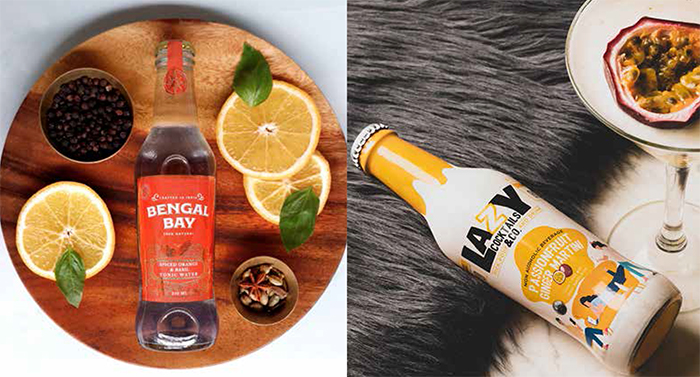
The trend has moved to dual-flavour tonics including Bengal Bay’s spiced orange and basil(L) and popular cocktail pre-mixes like the Passionfruit Martini (R) from Lazy Cocktails.
Organic & indigenous
Bengal Bay, founded by Rishabh Gupta, in keeping with the increased consumer interest in product provenance and process, likes to focus on the use of organic cane sugar and organically sourced indigenous botanicals. It also uses a cold blending process, much like cold brewing coffee, to achieve lower acidity and a smooth finish.
Punweet of Jade Forest (co-founded by Shuchir Suri) feels, “Since India has witnessed a large influx of international as well as home-grown gin brands, the type, flavour, nutritional ingredients and brand of tonic water have all become increasingly important to consumers.”
Sepoy&Co, founded in 2018 by Angad Soni, is another craft beverage company that has moved quickly to diversify its portfolio, starting with a range of tonics, moving swiftly to ginger ale, and then expanding into floral tonics and most recently a range of lemonades.
“When I started Sepoy&Co, there was hardly any interest given to drinks like tonics, ginger ales or other mixers. Today, full shelves are dedicated to soft drinks like tonics and mixers. That clearly gives you an indication of the acceptability of such drinks in India,” says Angad.
Goa based Vaum is the latest on the block, founded in 2019 by Aakash Khaunte and Siddharth Saraf. Their quest for the right mixers in India for superior gin and vodka took them to London mixologists, Liquid Fusion.
They helped develop seven flavours over two ranges, traditional quinine-based tonics and (in a mark of increasing sophistication of the sector) quinine-free botanical waters, now available in cucumber mint and mango fig flavours – the latter representing Indian brands using local flavours.
As a point of differentiation Punjab-based Gunsberg has focused on ginger (ale and beer) sourced from Sirmour (Himachal Pradesh) and juiced the same day of production.
A clear strategy for most Indian craft soft beverage companies is their portfolio expansion from tonic to soda, then ginger ale and now lemonades, and even RTD zero-proof mocktails.
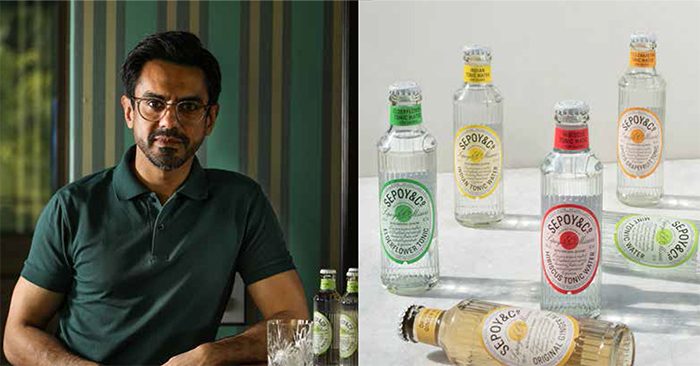
Angad Soni’s (L) Sepoy&Co now offers tonics, ginger ale, floral tonics and lemonades.
Imported mixers
International mixer companies present in most cases via India representatives have been entering the market at regular intervals. The ubiquitous Schweppes was the earliest, followed by Fever Tree and East Imperial.
One of the earlier luxury/ super-premium brands to enter was Franklin&Co., represented in India by Karan Jain of Bevs.in. Franklin was one of the first to introduce dual-flavoured tonics like their bergamot and pink grapefruit, rosemary and black olive.
Franklin has always prided itself on the source of its sparkling water from Staffordshire and carefully sourced ingredients from around the world. Karan says their products are quite in tune with the Indian consumers demand for “clean, sophisticated drinking”.
Delhi-based Saksham Impex recently brought Britvic and London Essence, the latter a brand they refer to as the “Ferrari of tonics”. Ashish Dubey of Saksham says, “London Essence is the only brand that is distilled from botanicals to deliver the slow lingering taste of the real herbs, flowers and fruits. It is crafted to perfection with experts from Grasse, in France.”
Japan’s Sakura Fresh also has Better Than Bitters, a range of non-alcoholic bitters, in the market with interesting flavours like Sandalwood and Marrakesh.
0.0 beer
Familiar beer brands like Heineken, Budweiser and Hoegaarden have also introduced low-alcoholic versions of their brands (< 0.03% alcohol in the case of Heineken). More popularly known as ‘0.0’, these have been brewed to give consumers the same malty taste of their favourite brew, but without the kick of alcohol.
The global non-alcohol beer market is estimated to surpass US$ 25 billion by 2024, but in India this variant accounts for less than 1% of the overall beer market.
Ramesh Viswanathan, Chief New Business Officer at United Breweries, sees their 0.0 customer to be a “health-conscious customer, who is seeking alternatives to traditional carbonated beverages in non-alcoholic occasions”.
Vineet Sharma, Vice-President Marketing at AB Inbev is happy that “70% of India’s consumers who have traditionally abstained from alcohol now have a viable alternative to enjoy beer in a social setting without alcohol”.
ABInbev has a robust presence in this segment with Budweiser-0.0, Hoegaarden-0.0 and Hoegaarden-0.0 Rosee. The latter is a flavoured beer, which Vineet says “has helped attract a lot of new women consumers into the category”.
The category is being further populated with the recently launched Coast, a 0.0 hazy IPA from Zero Percent, and the impending launch of St. Peter’s Original and Golden Ale (both 0.0) by Bevs.in.

Dexter Brew Labs founder Arvind Arul (L) has launched Floseltzers in coconut-mango and guava-peach flavours (R).
Hard/soft seltzers
Seedlip, the pioneering non-alcoholic distilled spirit, is already available in India in three variants (see Pg 26, interview with founder Ben Branson). Joining them are RumIsh and GinIsh from Zero Percent. As their names suggest, they are akin to their alcoholic counterparts (rum and gin) but without the alcohol.
Globally one of the breakout categories of the last few years has been the “hard” seltzer (carbonated water; ‘hard’ referring to alcohol content) in a range of flavours. India too has seen a couple of hard seltzers launches; but the soft seltzers are more remarkable.
Kati Patang’s move into “soft” seltzers (rather than a 0.0 beer) was also prompted by the fact that there were several established and large players already in the latter category.
Kati Patang describes its seltzers as non-alcoholic craft cocktails. The range includes a G&T, a Cosmopolitan and an Old Fashioned – all with the prefix ‘Not’ before them.
The other recent seltzer player is Dexter Brew Labs, with its brand called Flo, which is available in cans and in five flavours, including coconut-mango and delectable pink guava-peach. Its founder, Arvind Arul, recommends we try these with white rum.
Flo is a 0-calorie, 0-sugar and 0-carb drink with natural flavours. Arvind is aiming to incorporate zero-carbon emission methods for manufacturing and packaging, with an aim to become a carbon-neutral brand.
Cocktail mixers
The sudden rise of cocktail mixers has been quite overwhelming, and the wave has surely grown bigger during the pandemic lockdowns – several cocktail bars even began delivering “cocktail kits”.
While some of us became chefs at home, a few of us explored our bartender side as well. All one had to do was to spike the concoction with the choice of liquor and a delicious cocktail was ready in the comfort and safety of home.
One of the early birds in this category was Rakesh Sheth, a beverage industry veteran. After having worked with companies like Diageo and Pernod Ricard, he pioneered the category with his brand, ‘&Stirred’.
“We have always believed a ready-to-drink beverage may taste good with your alcohol, because everyone cannot make a cocktail. All our variants are in a single-serve pack, perfectly balanced for the universal spirit measure (60ml),” says Rakesh.
&Stirred offers a wide range of products – from classics like Pina Colada, Mojito, Bloody Mary to the latest range of mocktails such as Mexican Mule, Hibiscus Cosmo, to name a few.
Another popular company is Jimmy’s Cocktails, founded in 2019 by Ankur, Nitin and Mirza. Jimmy’s is a premium cocktail mixer brand, offering Whiskey Sour, Cosmopolitan, Mango Chilli Mojito, and Sex on the Beach.
Lazy Cocktails is the latest entrant in the segment with their Cosmopolitan, Bloody Mary and Passionfruit Martini. The company plans to launch more variants soon.
“Bartenders cater to only 10% of alcohol consumption in the country. Youth in India want variety when drinking at home, and cocktail mixers play an important role by providing bar quality cocktails at an affordable price,” says Himanshu, founder of Lazy Cocktails.
Bitters is a space that is currently dominated by foreign brands which predominantly provide for alcoholic bitters. Bab Louie has come up with non-alcoholic bitters, something unique.
“It was appropriate to showcase the massive legacy and tradition of Indian-grown and sourced spices and herbs and their medicinal attributes, so that we could add not just taste but also health to our customer’s drinks,” says founder Rishabh Bhatia.

Founder, Rishabh Bhatia (R) says bitters is the space that his Bab Louie & Co. has occupied.
Awareness, education
The drinking-at-home culture picked up after lockdowns and restrictions in the on-going pandemic. The mantra was simple: “To add soul to the spirit”. For its cocktail premixes segment, Bab Louie thought: Zero is the best figure to start from.
What this plethora of beverages has done is create a massive increase in choice, not just for the consumer, but for bars also. Linked to this is, of course, a better understanding of how a bar’s revenue and bottom line can be positively impacted by increased sales of these beverages.
Very few bars have yet evolved to having a wide selection of mixers that they can offer their guests, largely due to cost imperatives linked to investing in additional inventory, and a proper understanding of the various products and categories.
Rakshay Dhariwal, co-founder of PCO Hospitality, is amazed by the range that is on offer. He feels that the primary offtake of these beverages is with a spirit, rather than on their own.
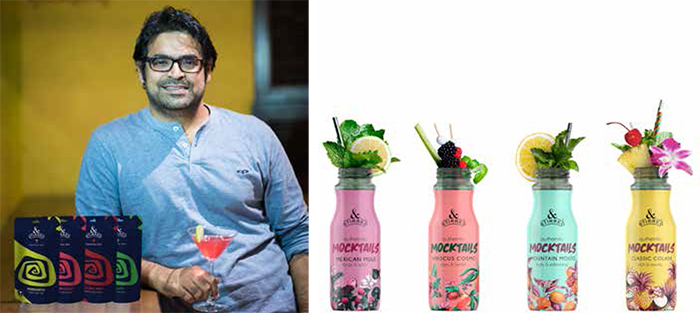
Rakesh Sheth’s (L) &Stirred has a range of popular cocktail pre-mixes and RTD mocktails.













